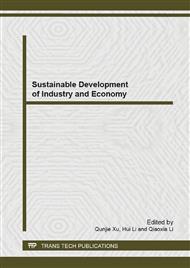[1]
J. T. Mentzer, Supply Chain Management, United States of America: Sage Publications, Inc., (2001).
Google Scholar
[2]
S. Chopra and P. Meindl, Supply Chain Management: Strategy, Planning, and Operation (5th ed. ) The United States of America: Pearson Education, Inc., (2013).
Google Scholar
[3]
K. Chandra and S. Kumar, Supply Chain Management in Theory and Practice: A Passing Fad or a Fundamental Change? Industrial Management & Data System, 100(3), pp.100-113, (2000).
DOI: 10.1108/02635570010286168
Google Scholar
[4]
S. Li, S. Subba Rao, T. S. Ragu-Nathan and B. Ragu-Nathan, Development and Validation of a Measurement Instrument for Studying Supply Chain Management Practices, Journal of Operations Management, 23, pp.618-641, (2005).
DOI: 10.1016/j.jom.2005.01.002
Google Scholar
[5]
C. Ninlawan, P. Seksan, K. Tossapol and W. Pilada, The Implementation of Green Supply Chain Management Practices in Electronics Industry. Proceedings of the International MultiConference of Engineers and Computer Scientists, 3, March 17-19, Hong Kong, (2010).
Google Scholar
[6]
A. A. Hervani, M. M Helms and J. Sarkis, Performance Measurement for Green Supply Chain Management. Benchmarking: An International Journal, 12(4), pp.330-353, (2005).
DOI: 10.1108/14635770510609015
Google Scholar
[7]
C. R. Carter and D. S. Rogers, A Framework of Sustainable Supply Chain Management: Moving Toward New Theory. International Journal of Physical Distribution and Logistics Management, 39(5), pp.360-387, (2008).
DOI: 10.1108/09600030810882816
Google Scholar
[8]
M. E. Porter and M. R. Kramer, Strategy and Society: The Link between Competitive Advantage and Corporate Social Responsibility, Harvard Business Review, 84(12), pp.78-92, (2006).
Google Scholar
[9]
A. Menon and A. Menon, Enviropreneurial Marketing Strategy: The Emergence of Corporate Environmentalism as Market Strategy, Journal of Marketing, 61(1), pp.51-67, (1997).
DOI: 10.1177/002224299706100105
Google Scholar
[10]
C. Lee, K. Lee and J. M. Pennings, Internal Capabilities, External Networks, and Performance: A Study on Technology-Based Ventures, Strategic Management Journal, 22(6/7), pp.615-640, (2001).
DOI: 10.1002/smj.181
Google Scholar
[11]
S. D. Hunt and R. M. Morgan, Resource-Advantage Theory of Competition: Dynamics, Path Dependencies, and Evolutionary Dimensions, Journal of Marketing, 60, pp.107-114, (1996).
DOI: 10.1177/002224299606000410
Google Scholar
[12]
E. Mosakowski, Entrepreneurial Resource, Organizational Choice, and Competitive Outcomes, Organizational Science, 9(6), pp.625-643, (1998).
DOI: 10.1287/orsc.9.6.625
Google Scholar
[13]
R. G. Schroeder, K. A. Bates and M. A. Junttila, A Resource-Based View of Manufacturing Strategy and the Relationship to Manufacturing Performance, Strategic Management Journal, 23(2), pp.105-117, (2002).
DOI: 10.1002/smj.213
Google Scholar
[14]
A. Paulraj, Understanding the Relationships between Internal Resources and Capabilities, Sustainable Supply Management and Organizational Sustainability, Journal of Supply Chain Management, 47(1), pp.19-37, (2011).
DOI: 10.1111/j.1745-493x.2010.03212.x
Google Scholar
[15]
D. Holt and A. Ghobadian, An Empirical Study of Green Supply Chain Management Practices Amongst UK manufacturers, Journal of Manufacturing Technology Management, 20(7), pp.933-956, (2009).
DOI: 10.1108/17410380910984212
Google Scholar
[16]
K. W. Green Jr, P. J. Zelbst, J. Meacham and V. S. Bhadauria, Green Supply Chain Management Practices: Impact on Performance, Supply Chain Management: An International Journal, 17(3), pp.290-305, (2012).
DOI: 10.1108/13598541211227126
Google Scholar
[17]
R. B. Kline, Principles and Practice of Structural Equation Modeling. (2nd ed. ) New York: Guilford Press, (2005).
Google Scholar
[18]
D. W. Gerbing and J. C. Anderson. An Updated Paradigm for Scale Development Incorporating Unidimensionality and its Assessment, Journal of Marketing Research, 25, pp.186-192, (1988).
DOI: 10.1177/002224378802500207
Google Scholar


